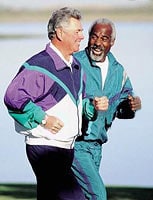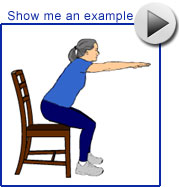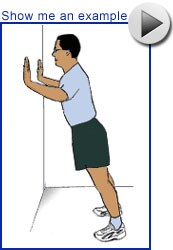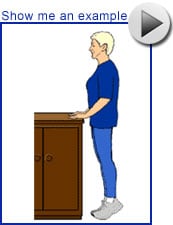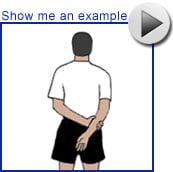
AT HOME
Good Saturday Folks,
Hopefully you had a great week and enjoyed your days with vigor and positive energy. I know I did and I want to share with each of you who may be hesitant to begin your wellness regime. Whether due to doubts about your ability to do it successfully or you do not have the knowledge that will allow you to develop a successful plan here is a beginning routine for you..
Well I've been at this for a long time and I am willing to share my knowledge with you. I also have done the research, spending many hours reading and then testing these routines, nutritional advice and chronic ailments, body types and every other areas of health and wellness on myself, to insure its efficacy.
The routine I am posting below is on the Center for Disease Control's website and I know it is great for working out at home and creating a healthier you. Why not try them out and write back to tell me if you are able to do them. If able try it for a couple of weeks and I know you will begin to feel better physically and mentally. Your spirits will rise as your muscle tone.
Exercises
These activities will help you build strength, maintain bone density, improve balance, coordination, and mobility, reduce your risk of falling, and help you maintain independence in performing activities of daily life. As you'll see, strength training requires little time and minimal equipment. And it's safe, even for people with health problems.
The strength training "prescription" featured here—the motivational tips, safety precautions, and specific exercises—were developed at the exercise research laboratory at Tufts University. Whatever your age, medical condition, or current level of activity, you are likely a perfect candidate for this gentle but powerful regimen of strengthening exercises.
The goal of this program is to help you make strength training a lifelong habit. By so doing, you will be on your way to a strong, independent, and vibrant life!
Warm up5-minute Walk
To get your muscles warm and loose for strength training, walk for five to ten minutes outside if weather permits, or inside around the house or on a treadmill if you have one. Walking will help direct needed blood flow to your muscles and prepare your body for exercise.
Warming up is important for preventing injury as well as gaining maximal benefit from the exercise, because loose, warm muscles will respond better to the challenge of lifting weights.
If you have another piece of aerobic exercise equipment available to you, such as a bike, rowing machine, or stair stepper, this will serve as an adequate warm up as well.
Stage 1
The following four exercises comprise Stage 1 of the Growing Stronger Program. When you've been doing the exercises of this stage for at least two weeks, OR if you are fairly fit right now, you can add the exercises in Stage 2. Remember to always do the Warm up and Cool down as part of each exercise session.
Squats
A great exercise for strengthening hips, thighs, and buttocks. Before long, you'll find that walking, jogging, and climbing stairs are a snap!
1. In front of a sturdy, arm less chair, stand with feet slightly more than shoulder-width apart. Extend your arms out so they are parallel to the ground and lean forward a little at the hips.
2. Making sure that your knees NEVER come forward past your toes, lower yourself in a slow, controlled motion, to a count of four, until you reach a near-sitting position.
3. Pause. Then, to a count of two, slowly rise back up to a standing position. Keep your knees over your ankles and your back straight.
4. Repeat 10 times for one set. Rest for one to two minutes. Then complete a second set of 10 repetitions.
Note 1: If this exercise is too difficult, start off by using your hands for assistance. If you are unable to go all the way down, place a couple of pillows on the chair or only squat down four to six inches.
Note 2: Placing your weight more on your heels than on the balls or toes of your feet can help keep your knees from moving forward past your toes. It will also help to use the muscles of your hips more during the rise to a standing position.
Make sure you:
· Don't sit down too quickly.
· Don't lean your weight too far forward or onto your toes when standing up.
Wall Pushups
This exercise is a modified version of the push-up you may have done years ago in physical education classes. It is less challenging than a classic push-up and won't require you to get down on the floor—but it will help to strengthen your arms, shoulders, and chest.
1. Find a wall that is clear of any objects—wall hangings, windows, etc. Stand a little farther than arm's length from the wall.
2. Facing the wall, lean your body forward and place your palms flat against the wall at about shoulder height and shoulder-width apart.
3. To a count of four, bend your elbows as you lower your upper body toward the wall in a slow, controlled motion, keeping your feet planted.
4. Pause. Then, to a count of two, slowly push yourself back until your arms are straight—but don't lock your elbows.
5. Repeat 10 times for one set. Rest for one to two minutes. Then complete a second set of 10 repetitions.
Make sure you:
· Don't round or arch your back.
Toe Stands
If a walk in the park no longer seems easy or enjoyable, the "toe stand" exercise is for you! A good way to strengthen your calves and ankles and restore stability and balance, it will help make that stroll in the park fun and relaxing.
1. Near a counter or sturdy chair, stand with feet shoulder-width apart. Use the chair or counter for balance.
2. To a count of four, slowly push up as far as you can, onto the balls of your feet and hold for two to four seconds.
3. Then, to a count of four, slowly lower your heels back to the floor.
4. Repeat 10 times for one set. Rest for one to two minutes. Then complete a second set of 10 repetitions.
Make sure you:
· Don't lean on the counter or chair—use them for balance only.
· Breathe regularly throughout the exercise.
Finger Marching
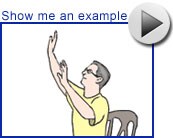
In this exercise you'll let your fingers, hands, and arms do the walking. This will help strengthen your upper body and your grip, and increase the flexibility of your arms, back, and shoulders.
1. Stand, or sit forward in an armless chair, with feet on the floor, shoulder-width apart.
2. Movement 1: Imagine there is a wall directly in front of you. Slowly walk your fingers up the wall until your arms are above your head. Hold them overhead while wiggling your fingers for about 10 seconds and then slowly walk them back down.
3. Movement 2: Next, try to touch your two hands behind your back. If you can, reach for the opposite elbow with each hand—or get as close as you can. Hold the position for about 10 seconds, feeling a stretch in the back, arms, and chest.
4. Movement 3: Release your arms and finger-weave your hands in front of your body. Raise your arms so that they're parallel to the ground, with your palms facing the imaginary wall. Sit or stand up straight, but curl your shoulders forward. You should feel the stretch in your wrist and upper back. Hold the position for about 10 seconds.
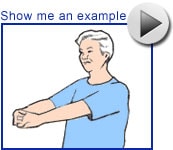
5. Repeat this three-part exercise three times.
These are simple routines for people who are just beginning sustained physical activity but may be inserted into any routine for those days when you are not able to get to a facility. Even if you are more advanced, they help to sustain activity while traveling or otherwise preoccupied with the responsibilities of life.
So even if trapped in the house with no way to get out there is no reason to not Get Up, Get Moving, Get Well since we all know,
"CHIT CHAT WON'T BURN FAT"


